The Land Of China -- Explore by Province
 |
 |
Jiangxi
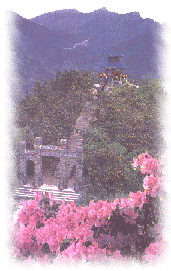
|
Jiangxi Province has a long revolutionary history. On August 1, 1927, the Chinese Communist Party led the famous August 1 Nanchang Uprising. In the Jinggangshan Mountains the revolutionary red base was established and was led by Mao Zedong in 1927. The city of Ruijin was once the capital of the Central Revolutionary Base. Anyuan was where the early worker movement took place. Jiangxi also has famous tourist attractions: Mount Lushan, the Jinggangshan Mountains, Jingdezhen, and many other sites of historical significance.
Jiujiang is a large port on the south bank of the Yangtze, between Wuhan and Nanjing. It is bounded on the east by Poyang Lake and on the south by Mt. Lushan. Its Donglin Temple is the birthplace of the "Pure Earth" sect of Buddhism (founded over 1,500 years ago). The Poyang Lake Migrant Birds Reserve is said to be the largest in the world. Visitors can go to the Yanshui Pavilion, a 1840-square-meter island in the middle of Lake Gantang covered with gardens and pavilions.
Yanshui Pavillion, Mist and Water Pavillion
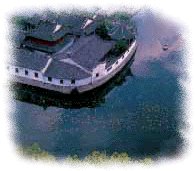
|
Standing on a 1,400 square meter isle in Lake Gantang, Yanshui Pavilion is located in the center of Jiujiang City. Though called a pavilion, it is a series of structures connected by corridors and small paths. Beautiful names have been given to the various buildings, such as the Chuanting Hall, the Cuichaoxian Pavilion, the Jingbo Tower, and the Jinyue (Moon-Reflection) Pavilion.
Yanshui Pavilion has a long history, and got its name from the famous Tang Dynasty poet Bai Juyi. When he was banished from the capital, he stayed in Jiangzhou (present-day Jiujiang) and often visited a favorite spot on the isle. Here he wrote a poem with the following famous lines:
Sitting by the water and holding a soft branch of willow, I gradually recall all the past events which seem to be happening in a previous existence.
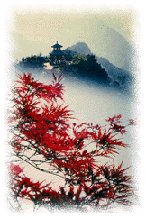
|
Lu Shan
Lushan, in Jiujiang, is one of China's most famous mountains. Its scenery has attracted tourists throughout all of China's history.

|
Lushan is abundant in scenic spots, springs, rocks of fancy shapes, and waterfalls, for which it is especially famous. In the summer Lushan is a perfect resort place, and in the winter it presents a unique snow clad mountain view. On the mountains there are also many ancient temples and Buddhist cultural relics.
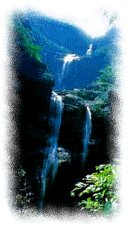
|

|
Jingdezhen, in northeast Xiangxi, has a population of 290,000. Jingdezhen is especially famous for its manufacture of porcelain and is known as the Porcelain Capital of China. Jingdezhen has a history of porcelain-making that goes back more than 1,000 years. In as early as the Sui and Tang Dynasties, porcelain-making here was already well-known, and the porcelain products are described as Jade-like wares. Jingdezhen has also become a tourist attraction. Many spots to visit are connected with the porcelain-making, such as the Museum of Ceramic History, the Ancient Hutian Kiln Site, and various porcelain factories.
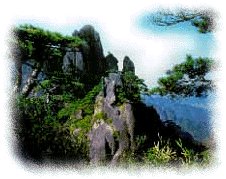
|
Located in Shangqing County of Yingtan, the Heavenly Masters Mansion used to be the residence of Taoist masters. The mansion was built during the years of Yongjia of the Western Jin Dynasty (307 - 313). It was renovated several times in the later years. Now the mansion occupies an area of 6,000 square meters with a complex of buildings. Presently there are three halls, three courtyards, and more than 500 houses.
Twenty kilometers south of Yingtan is a famous mountain recognized as the sacred mountain of Taoism, Mount Long-Hu meaning "Mount Dragon and Tiger", which is now classified as a state protection park.
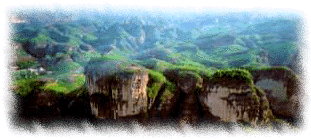
|
Jinggangshan
The Jinggangshan region, situated in the Laoxiao mountains along the Hunan-Jiangxi border, played a crucial role in Chinese revolutionary history. In October 1927 Mao Zedong, leading the Autumn Harvest Uprising army, came to Jinggangshan to set up the first rural revolutionary base. The struggles experienced by Mao Zedong in Jinggangshan signifies the beginning of the revolutionary road toward victory. Now Jinggangshan has become a tourist attraction. Scenic spots include Huangyangjie Pass, Ciping, Jinggangshan Revolutionary Museum, and other sites of revolutionary significance.
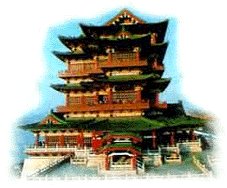
|
The Tengwang Pavilion in Nanchang is one of the three famous towers south of the Yangtze River. The tower stands on the bank of the Ganjiang River. In 659, the Governor of Hongzhou, Li Yuanying (brother of Li Shimin, Emperor of the Tang dynasty) built a tower for his villa on the bank of the Ganjiang River. People called it Tengwang pavilion when he was made the Prince of Teng. In the later years the tower became a gathering place for scholars to recite poems and sing. The famous poet of the Tang Dynasty, Wang Bo, wrote a famous essay here, "Notes on Tengwang Pavilion", which made the pavilion even more well-known. The tower has been destroyed 28 times, and in 1983 it was rebuilt. It is 45 meters high with an area of 5,600 square meters. From the exterior the tower appears that it has three stories, but inside it actually has five.
Immortals Cavern
The Immortals Cavern cave is below the Buddhas Hand rock and at the foot of a high cliff. Cone-shaped at the top with trees providing shade, the cavern is said to be the place where Lu Dongbin (a character in Chinese fairy tales) meditated and became one of the Eight Immortals who crossed the sea by displaying his respective power.
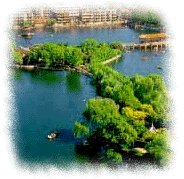
|
Hundred-Flower Islet
The Hundred Flower Islet has a hill on top of which stands a pavilion, Guanao Pavilion. The islet is situated in the center of a lake. In ancient times, famous poets and men of letters liked to visit the place to write a number of writings about its surrounding scenery.



 Chinese Culture
Chinese Culture